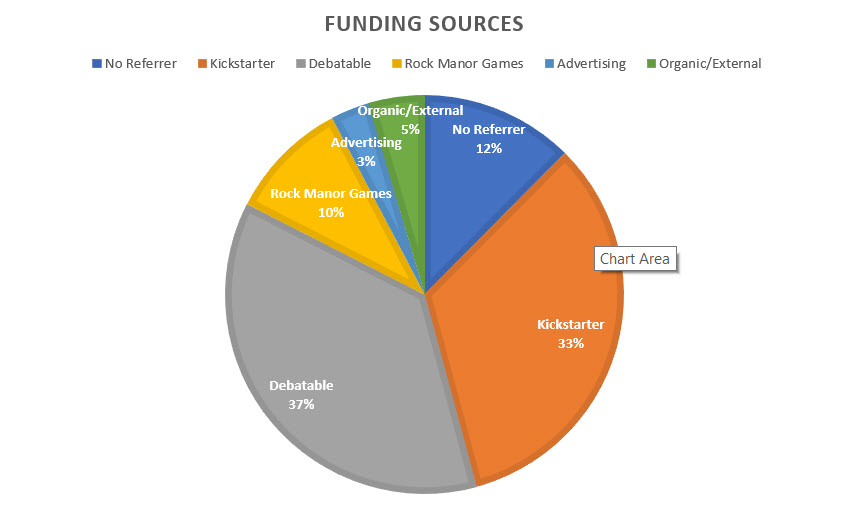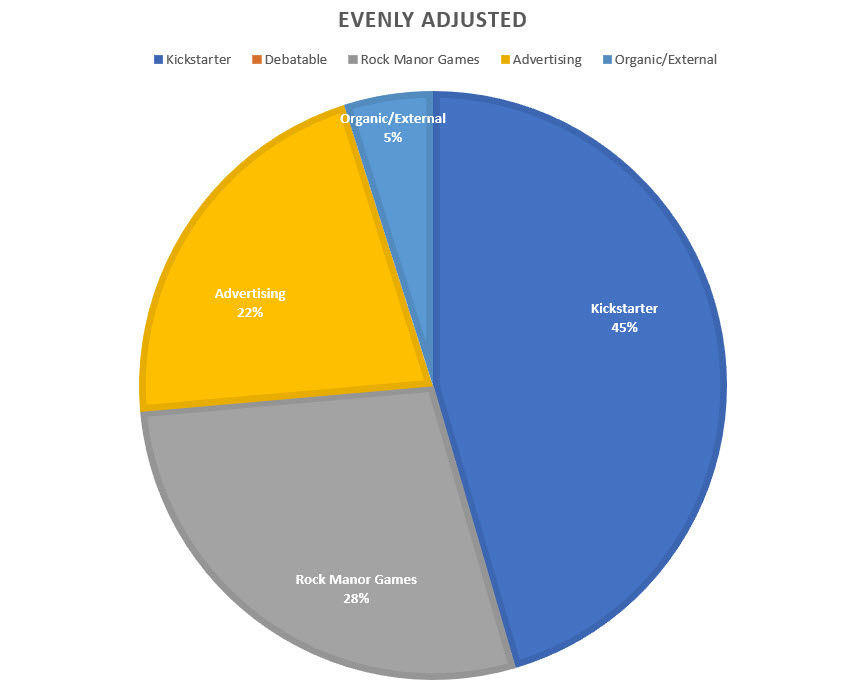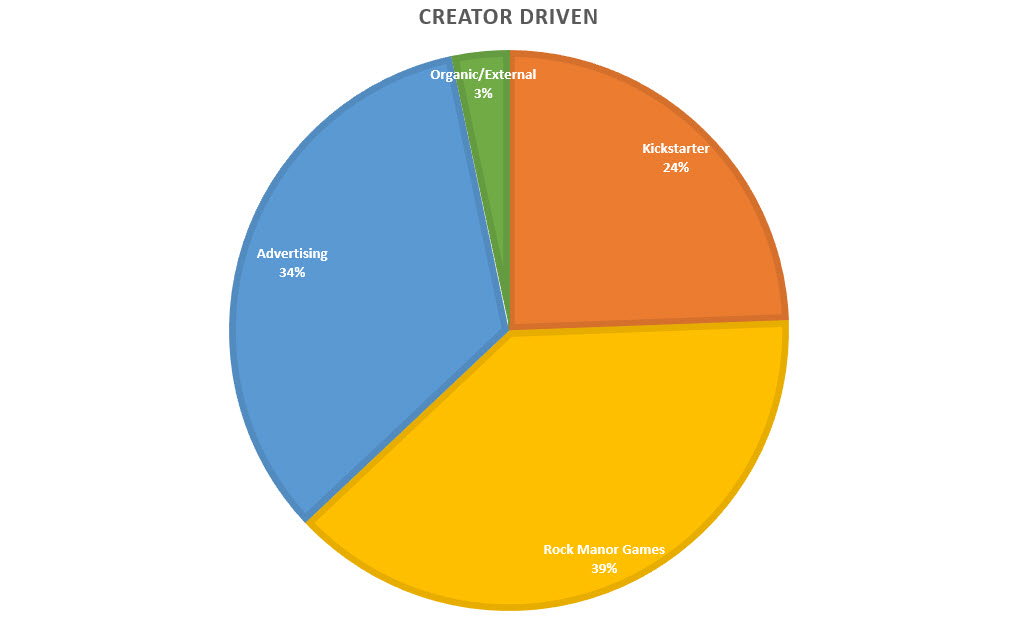This is a follow-up to my ongoing series of How to Advertise your Kickstarter posts, which directly resulted in me getting invited to the amazing “How to think like a Game Designer” podcast. As a disclaimer, remember there are NO SHORTCUTS to Kickstarter success.
I want to reiterate a point I’ve made in some of these other posts that you have to have faith that advertising/marketing works because tracking metrics exactly is impossible. Furthermore, Kickstarter likes to take credit for a lot of your backers because of their imperfect referral system.

Set a Watch: Swords of the Coin was our biggest DAY 1 we’ve ever had on Kickstarter. Part of this is because I’d like to think we have gained a small following at this point – but it’s also because we spent money advertising our pre-launch page on Kickstarter and had 2650 followers when we clicked the Launch button.
Deciphering the exact amount that our advertising this pre-launch generated is difficult. Certainly a large portion had to do directly with fans of Rock Manor Games and not random Kickstarter users stumbling on our project on day 1. Kickstarter doesn’t just magically bring you 72% of your project funding goal does it? This lead me down the path of going through Kickstarter’s many many different referral codes so that I could decipher and piece this all together.
So here’s my handy guide to what each Kickstarter referrer is (as best as I can tell):
This first group of referral codes are features that Kickstarter’s staff and company deserve a lot of credit for. It’s not that 100% of these people discovered your project on Kickstarter – it’s just that all these categories are great features of the platform that in most cases are driving people to your project.
Advanced Discovery – Someone clicked on Explore and clicked “Games” then probably “Tabletop” and used other search filters to browse and find our game. The point is that this is a true Kickstarter lead from someone exploring/browsing the site.
Discovery (general) – for this campaign, I had additional line items for Recommendations (Discover), Tabletop Games (Discover), Discovery category newest, Discovery category popular, Discovery similar etc. etc. The point is that these backers are all fairly attributed to Kickstarter. The platform generates a lot of traffic and has visitors browsing for neat things to back.
Recommendations – When you login to Kickstarter, they customize your home page with recommendations based on your backing history. Kickstarter is more sophisticated than that though and there were a ton of referrals for Recommendation-projectpage-footer. I’m pretty sure these recommendations in the footers appear when you back a project and show of other campaigns you might be interested in pledging. Great work Kickstarter staff!
Internal – I think this is similar to Kickstarter’s discovery system. They know you came to the page and backed via some Kickstarter.com internal link but may have lost the exact referrer info. I’m going to lump in some of my other smaller referrals in here like Android deep link, Checkout payment sources page, Android share, Checkout rewards page, etc.
Email: backer’s friends notified of their pledge – This is an email/notification from Kickstarter to backer’s friends saying “Your friend Johnny just backed Set a Watch: Swords of the Coin” and then you’re all like WOW I’m backing that too!
Activity Feed – A user’s activity feed is filled with updates from projects they’ve backed, notifications of what their friends have backed, or notifications of creators that you follow. This one gets a little dicey because people that follow me as a creator will see that I launched a new project in this feed, but I still think it’s more a testament to the Kickstarter platform and fair to give them that referral.
My next category of Kickstarter referrals is what I’m going to label as “Debatable” as in it is debatable if that person came to Kickstarter and discovered us there or already was aware and looking for us (i.e. they were aware of our project from another source).
Search – This code corresponds to people that used the search field to find a project and then backed it. Now they could have been browsing Kickstarter and discovered our project and then clicked around some more and had to use search to go back and find us… or they knew our project’s name from another source.
Email – Someone clicked on a link from a Kickstarter email. Some emails like the one mentioned above – are fair to attribute to Kickstarter because they’re generating traffic to their site, emailing you projects you find interesting etc but it’s weird that some Email referrals have specific info and others do not. The Email: last chance to back reminder is a great service Kickstarter offers at the 48hr left mark and is always a big referrer but where did those backers first hear about the project? Did they click an ad? Did they discover it on Kickstarter? Unfortunately, we don’t know.
Profile saved / starred – Kickstarter allows you to save/star projects to track them in your profile, so this referral is when someone backs from browsing their profile and saved projects. I actually use this feature A LOT and am constantly browsing Kickstarter and saving projects to watch AND click advertisements and other links on Facebook to projects which I then star and follow as well.
This last batch of referrals is “Creator Driven”. I think these are very likely “stolen” and credited to Kickstarter from other sources. Stolen may be a strong word, but these are all referrals I think have a whole lot more to do with the Creator’s effort than Kickstarter’s traffic/discovery platform.
Push – Someone has the Kickstarter app on their phone or tablet and was notified that you launched a campaign. For this example, I think that this figure specifically had do with our pre-launch promo page on Kickstarter and all the followers we gathered before launch.
Email: friends notified when your project launched – Someone gets an email when your project launches and backs from there. Again, I think this is primarily driven by Creators’ own crowd and something I attribute to Rock Manor Games rather than Kickstarter.
Updates – Someone clicks on a Kickstarter update and then backs your project. I used referral links for everyone of my KS updates that linked to Swords of the Coin, but I think that those referral codes can get stripped out or perhaps this is a backer who is looking through our current campaigns updates and reading them before backing. Either way, creators are the ones writing updates on projects.
Let’s take a look at my projects funding sources when I attribute the “Creator Driven” referrals back to Rock Manor Games (which also includes all of our custom referrals that we created for our newsletter, KS updates, Project Preview etc):

That “Debatable” referral is now the largest portion of our graph! That brings us to the No Referrer portion:
Direct, no referrer information — Someone visited the link directly, not from email, Kickstarter or social media. It could be an app, incognito browser or copy/pasted URL.
This direct traffic is almost certainly from a Creator’s efforts both organically and because of their marketing and advertising so I split this portion evenly between Rock Manor Games and Advertising. Next, I evenly split the “Debatable” KS referrals between Kickstarter, RMG and Advertising:

Last but not least, I looked at the extreme case where all those debatable KS referrals were actually a result of our marketing efforts and evenly split that section between RMG and advertising:

At the extremes, we were directly responsible for 73% of our funding as opposed to Kickstarter’s referral metrics attributes 72% of the funding to their site. After deciphering Kickstarter’s referral metrics, I think we can all agree that their estimate is a bit high. I think the truth lies somewhere in between my “Evenly Adjusted” and “Creator Driven” graphs (but even those are guestimates).
Here is where the faith in advertising and marketing comes in. I arbitrarily assigned additional fundraising to our advertising efforts and as you will see in a future post – the direct quantitative tracking and ROI on a lot of those advertisements was not great. It’s important to analyze the metrics you have, but it’s not a perfect science. You can’t consumed by every marketing dollar and have to have faith that it works. After all why else would McDonald’s spend millions of dollars a year on TV ads alone.
Interested to hear what other Kickstarter creators think… what portion of fundraising do you attribute to your efforts versus advertising and Kickstarter? Does Kickstarter “steal” referrals? What other KS referrals did I miss that need to be decoded?

lowenhigh
This is an excellent sum of the feeling I have had since I have marketed other client projects. Interestingly enough, I also had many discussions with Justin Gary on this subject, as I worked on his pre-launch marketing and campaign for Ascension Tactics. It was difficult to determine the true ROI of ads, but undeniable that the spend was working!
I would be curious as to your thoughts on how Google Analytics data compares with your FB Ad data. Specifically, what do you think about bounce rates listed in GA and Kickstarter?